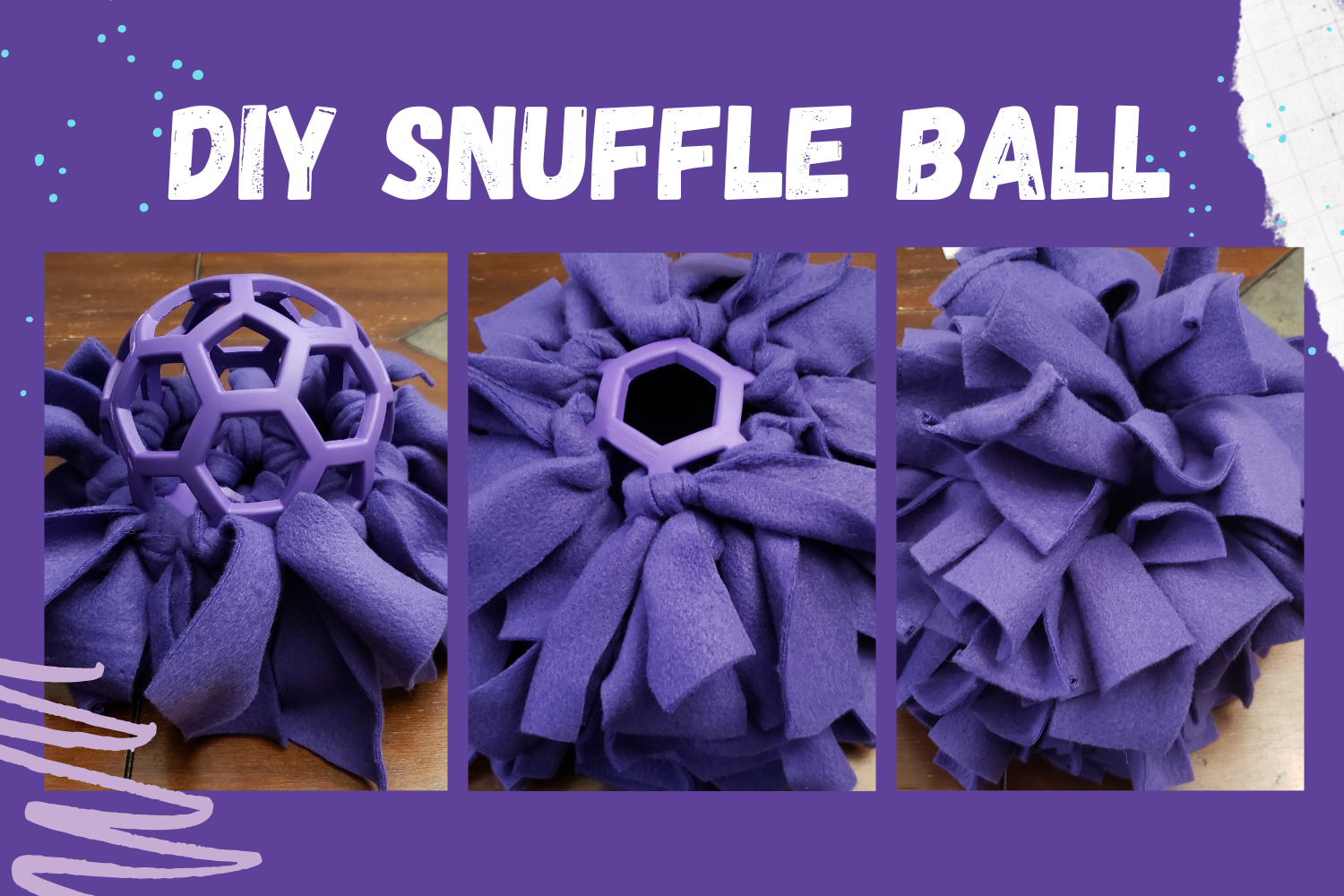Is your dog bored? Is it too hot or too rainy to do things? If you are looking for a new way to tire out your pup, then this is the tutorial for you! Follow along to make your own DIY Snuffle Ball.

DISCLOSURE: This post contains affiliate links. I may earn a commission if you shop through my links, at no added cost to you. For more information, see the footer at the bottom of the page.
What is a Snuffle Ball?
A snuffle ball is a big poofy puzzle ball. They are typically made with fleece or felt, and are designed to obscure the treats inside so that the dog has to use their nose and noggin to get the goods out. They are not meant to be especially hard, just to make the dog think a bit. Snuffle balls can be used as an alternative to slow-feeders if you have a dog that tends to eat too fast. If I had to make a comparison, this ball is similar to (but slightly more versatile than) a Kong Wobbler Puzzle Feeder. You can also find snuffle mats and a variety of other snuffle toys. They are especially enticing to hound breeds and dogs who love food.

You will need:
- About 2/3 of a yard of fleece (Pictured here is 1 yard of purple and 1 yard of orange)
- JW Hol-ee Roller ball (Pictured is a Large and Jumbo)
- Scissors
- Measuring tape or a standard ruler
I got my fleece from Jo-Anns on sale for about $6/yard. You don’t need anything fancy, just basic fleece in whatever color or pattern your pup might like best. Amazon also has a pretty nice selection of fleece by the yard if you’d like to skip the store altogether. I only used about 2/3 of a yard, but I would recommend just getting a whole yard. You can use the extra for replacement strips or another craft project!
I am using the Large Hol-ee Roller. I initially bought both a large and jumbo, but the jumbo ended up being way too big for this project. You could still do it, but you would need more strips of fleece (I would recommend tying two strips on every edge instead of one for a nice full ball). You can also go smaller if you want! If you go smaller I would make the fleece strips slightly thinner and shorter.
First Things First

Before we can do anything, we need to cut up our fleece! For this DIY Snuffle Ball I recommend 2″x10″ strips, but you could go as big as 3″x12″ if you want a harder puzzle. The larger you go, the bulkier your knots will be in the next step. The bulkier knots will leave your completed ball with smaller holes, making the puzzle harder for your dog. For the large ball, you will need 85 strips of fleece in your choice of color(s).
Tying The Knot

Put on some music or a familiar TV show, cause this part takes a while. I spent about 3 days casually adding to my ball while we watched TV after dinner until it was all finished. You’re gonna wanna tie one strip of fleece around every single edge of the ball (use two strips or really thick strips if you’re attempting a Jumbo size ball). I suggest working in order in layers around the ball, it’s very easy to miss edges as the ball fills up if you are going in randomly. You can make the strips longer or shorter to your preference. I think next time I am going to try 12″. You don’t want to tie them too loose, but be mindful that the tighter your knots are, the bigger the final holes will be. I used single overhand knots.

Play Time!
Now that we’ve finished this thing, how do we use it? This DIY Snuffle Ball is very easy to play with. Locate the one filled in hole (every ball has one) and make sure that it is on the bottom. This will help hold our treats so they don’t fall out while we are filling and transporting the ball. Then separate the strips on the top until you can see the hole, and fill the ball with kibble/treats (you might want to use a funnel).

My finished large ball will hold about a cup of kibble. Our kibbles are small enough that they basically fall right out when the ball is moved around, so it’s a very easy puzzle. Sometimes I will crank up the difficulty by using larger treats like this Milk-Bone Trail Mix or the Large Milk-Bones. The large Milk-Bones will not come out of the ball unless the dog can figure out how to break them up into small enough pieces, it’s very challenging!
While playing with it, your dog may figure out how to untie some of the strips. You can discourage this, or simply pick them up and tie them back on. I would advise supervision with this toy, you don’t want the dog to chew it up so supervise until you are confident they’ve learned how they should play with this new toy.
Drop a comment below if you make one and let me know what your pup thinks!

Leave a Reply